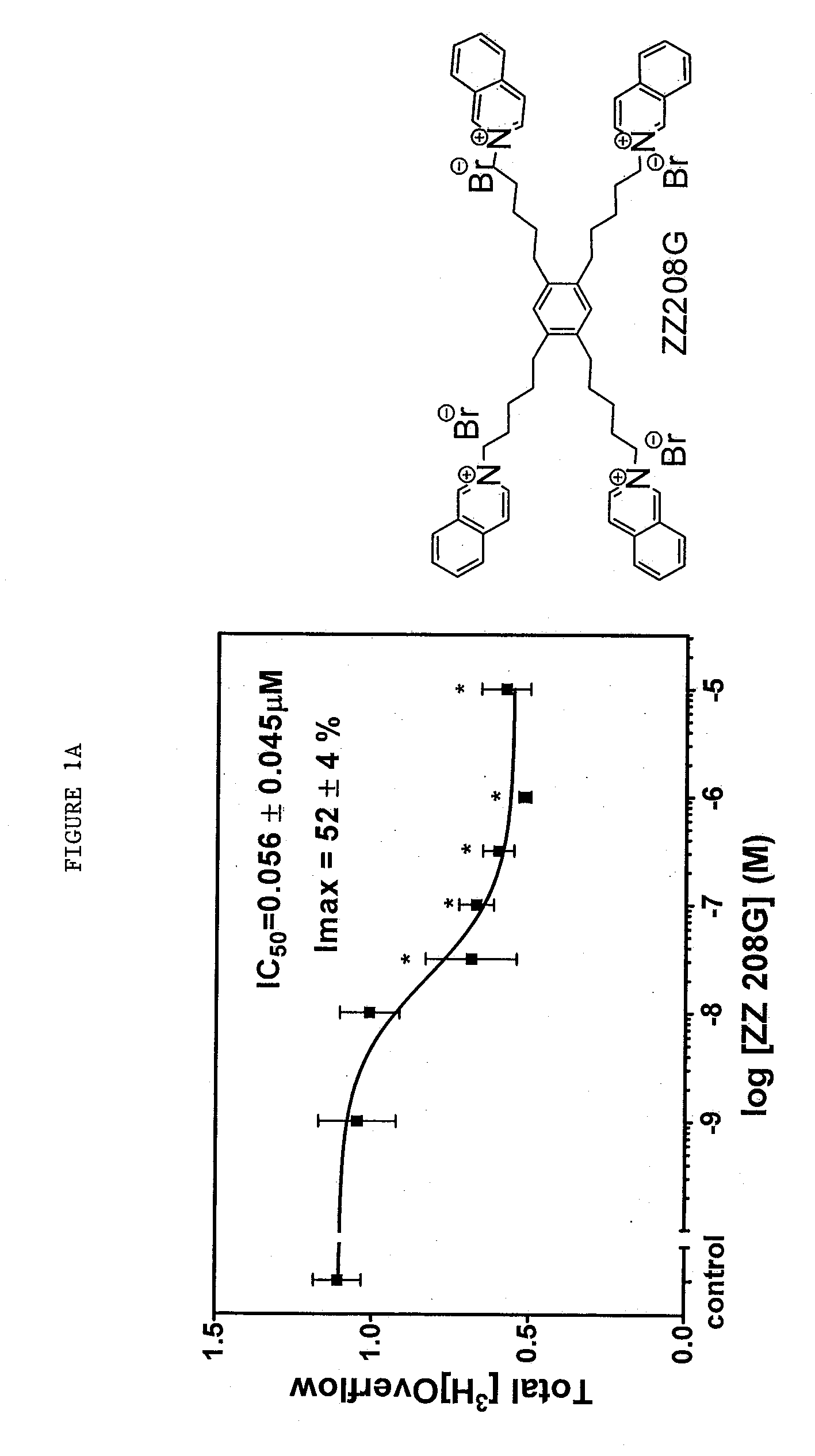Tetrakis-quaternary ammonium salts and methods for modulating neuronal nicotinic acteylcholine receptors
- Summary
- Abstract
- Description
- Claims
- Application Information
AI Technical Summary
Benefits of technology
Problems solved by technology
Method used
Image
Examples
example 1
Preparation of 1,2,4,5-tetraiodobenzene
[0146]
[0147]Periodic acid (2.56 g, 11.2 mmol) was dissolved with stirring in concentrated H2SO4 (60 mL). Potassium iodide (5.58 g, 33.6 mmol) was crushed and added to the clear solution. After about 30 min of stirring, the dark mixture was placed in an ice bath. The aromatic substrate (C6H5, 1 mL, 11.2 mmol) was then added slowly. The reaction was allowed to stir to room temperature for 1 day and poured onto crushed ice. The resulting solid was collected by suction filtration and washed well with methanol to remove iodine. The crude lavender powder (5.4 g 82% yield) was crystallized from 2-methoxyethanol, giving 1,2,4,5-tetraiodobenzene (71% yield) as white needles, mp 252-255° C. 1H NMR (Me2SO-d6) δ 8.32 (s); 13C NMR (Me2SO-d6) 147.1, 108.5 ppm.
example 2
Preparation of 5,5′,5″,5′″-(1,2,4,5-benzentetrayl)-tetrakis(4-pentyn-ol)
[0148]
[0149]To a degassed solution of 1,2,4,5-tetraiodobenzene (5.81 g, 0.01 mol) in DMF-Et3N (100 mL, 1:1) were added Pd(PPh3)2Cl2 (350 mg. 0.5 mmol), CuI (200 mg, 1.2 mmol), and 4-pentyn-1-ol (4.2 g, 0.05 mol) was added drop-wise. The mixture was stirred under N2 at room temperature for 24 h. The solution was poured into water (400 mL). The mixture was extracted with CH2Cl2 (3×200 mL). The combined organic phases were washed with 5% HCl and brine, dried over Na2SO4, and concentrated under vacuum. The residue was purified by silica gel column chromatography using CH2Cl2-MeOH (10:1, v / v) as eluent to afford tetramer (3.34 g, 82%): 1H NMR (300 MHz, CD3Cl+CO3OD δ ppm), 7.30 (s, 2H), 3.72 (t, J=6.3 Hz, 8H), 2.52 (t, J=7.2 Hz, 8H), 1.80 (p, J=6.6 Hz, 8H) ppm.
example 3
Preparation of 5,5′,5″,5′″-(1,2,4,5-benzentetrayl)-tetrakis(1-bromo-4-pentyne)
[0150]
[0151]5,5′,5″,5′″-(1,2,4,5-benzentetrayl)tetrakis-4-pentyn-ol (2.05 g, 5.03 mmol) and carbon tetrabromide (7.41 g, 22.35 mmol) were dissolved in dry methylene chloride (100 mL) and cooled to 0° C. Triphenyl phosphine (6.16 g, 23.47 mmol) was added portion-wise and the mixture was stirred at RT. After the starting alcohol was consumed methanol was added and the mixture was stirred for an additional 5 minutes. The mixture concentrated and was treated with hexanes (500 mL) and then filtered through a short silica gel column, washed with ethylacetate / hexanes (1 / 4). The combined organic solvents were evaporated to dryness under reduced pressure. The resulting residue was purified by column chromatography (hexanes) to afford 2.84 g of the title compound. Yield: 89%. 1H NMR (300 MHz, CDCl3) δ 7.39 (s, 2H), 3.62 (t, J=6.3 Hz, 8H), 2.67 (t, J=6.6 Hz, 8H), 1.14 (p, J=6.6 Hz, 8H) ppm.
PUM
| Property | Measurement | Unit |
|---|---|---|
| Pharmaceutically acceptable | aaaaa | aaaaa |
Abstract
Description
Claims
Application Information
 Login to View More
Login to View More - R&D
- Intellectual Property
- Life Sciences
- Materials
- Tech Scout
- Unparalleled Data Quality
- Higher Quality Content
- 60% Fewer Hallucinations
Browse by: Latest US Patents, China's latest patents, Technical Efficacy Thesaurus, Application Domain, Technology Topic, Popular Technical Reports.
© 2025 PatSnap. All rights reserved.Legal|Privacy policy|Modern Slavery Act Transparency Statement|Sitemap|About US| Contact US: help@patsnap.com



